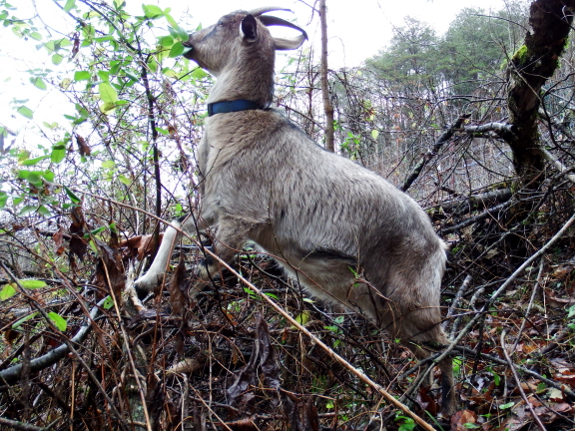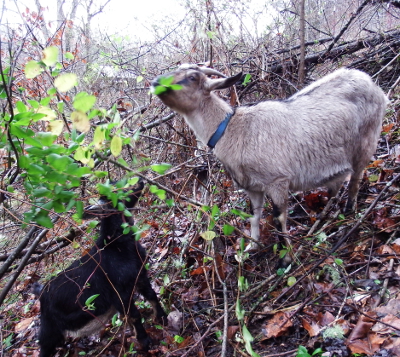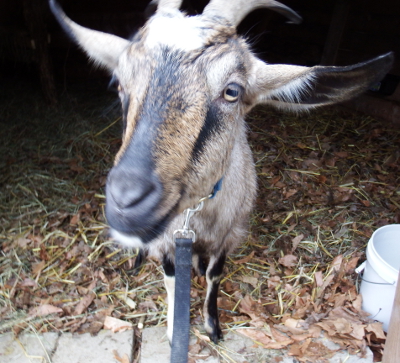
Feeding tree leaves to goats for winter fodder

In the wild, goats would
primarily eat tree leaves, which tend to be higher in minerals than
grass and carry a lower risk for spreading internal parasites. So it's
no surprise that when people talk about winter fodder for goats, they
often talk about feeding them dried tree leaves. I love the idea, but,
unfortunately, that's all it is to most people --- an idea. Only one website that I've found so far has provided actual information on how
to gather tree leaves for goats, so if you want the long version, feel
free to follow that link. For the short version, read on....
First of all, I should
mention that, while goats will sometimes eat fallen autumn leaves, this
isn't the kind of high-nutrition foodstuff that the goat owner should be
looking for. As you probably learned in elementary school, tree leaves
turn color in the fall as the plant sucks  many
of the important nutrients back out of the leaf and into the trunk, so
fallen leaves are more akin to straw than they are to hay. A goat might
eat some fallen leaves, but they're not going to fare very well on a
diet of fallen leaves alone. Instead, if you opt to save tree leaves for
winter feed, your goal should be to strip the leaves from the trees
while they're still green, dry them, and then store the leaves like you
would hay.
many
of the important nutrients back out of the leaf and into the trunk, so
fallen leaves are more akin to straw than they are to hay. A goat might
eat some fallen leaves, but they're not going to fare very well on a
diet of fallen leaves alone. Instead, if you opt to save tree leaves for
winter feed, your goal should be to strip the leaves from the trees
while they're still green, dry them, and then store the leaves like you
would hay.
Okay, so how does one go
about this process, which I've seen called "shredding," or making "tree
hay" or "pollard hay"? Since trees leaves are often out of reach, the
first step is usually to create a coppice
or pollard system --- which we luckily have growing up in our powerline
cut at this very moment. (No, we didn't create it. When the electric
company whacked down all of the big trees after a storm, many small
sprouts came up from their base --- instant coppice.)
Once you have a coppice system, you harvest the small stems and their
attached leaves in the summer at two-to-six-year intervals. At this
time, the young branches are usually around four or five feet long, and
they can be allowed to dry for a day on the ground, then are tied up
into bundles (a bit like corn shocks) to dry another two or three days in the field before being moved to the barn.
 The
trick seems to be finding tree species that handle coppicing well and
that also hold onto their leaves when dry, since you don't want to be
stuck raking dried leaves out of the summer grass --- it's much easier
to simply carry leafy branches to winter storage all in one bundle. In
Bulgaria, maple, hornbeam, ash, mulberry, some oaks, willow, linden, and
elm are most frequently used and are harvested any time between mid
July and the end of September, while in Italy, farmers focus primarily
on ash and harvest in late August.
The
trick seems to be finding tree species that handle coppicing well and
that also hold onto their leaves when dry, since you don't want to be
stuck raking dried leaves out of the summer grass --- it's much easier
to simply carry leafy branches to winter storage all in one bundle. In
Bulgaria, maple, hornbeam, ash, mulberry, some oaks, willow, linden, and
elm are most frequently used and are harvested any time between mid
July and the end of September, while in Italy, farmers focus primarily
on ash and harvest in late August.
This process of harvesting tree leaves for winter fodder is often called
shredding, probably because the leaves are plucked from the twigs in
the winter before feeding. Then the branches that are left behind can be
used for firewood.
I love the elegance of the system, and am curious to see how
time-consuming it would be to pack away fodder for two small goats. The
biggest stumbling block at the moment is where to store the tree hay ---
I guess we'll need to put a hay loft on our winter to-do list!
Want more in-depth information? Browse through our books.
Or explore more posts by date or by subject.
About us: Anna Hess and Mark Hamilton spent over a decade living self-sufficiently in the mountains of Virginia before moving north to start over from scratch in the foothills of Ohio. They've experimented with permaculture, no-till gardening, trailersteading, home-based microbusinesses and much more, writing about their adventures in both blogs and books.
Want to be notified when new comments are posted on this page? Click on the RSS button after you add a comment to subscribe to the comment feed, or simply check the box beside "email replies to me" while writing your comment.

Great idea!!! I raised dairy goats for 3 years but found them to be way to high input.. Took a year off to try sheep.. Which failed! For many reasons ! Now I'm trying fainting goat and small dairy goat crosses with much better results,, much lower input! This would be perfect to do for them I think since they do not need near as much food as a high production dairy goat!! This is going on my research/to do list!
A woman in Maine is giving classes on how to do pollarding.
http://3streamsfarmbelfastme.blogspot.com/